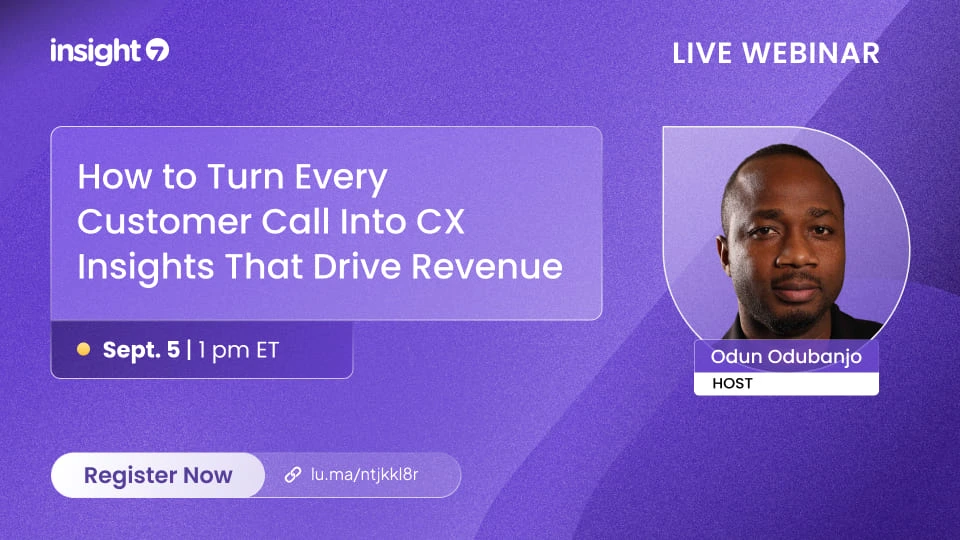How to Analyze Product Experience
-
Bella Williams
- 10 min read
Product Experience Analysis is a critical process that helps businesses understand how users interact with their products. Imagine a new app launch: users download it, explore its features, and provide feedback. Their insights can highlight both strengths and weaknesses, guiding product improvements. In this section, we’ll delve into why analyzing product experience is essential for enhancing user satisfaction and fostering brand loyalty.
By scrutinizing feedback and behavior patterns, organizations can identify users' needs and expectations. This analysis not only reveals pain points but also uncovers opportunities for innovation. Understanding user experience deeply can lead to better design decisions, increased engagement, and ultimately, a more successful product in the market.
Generate visualizations from your qualitative data. At Scale.

Understanding the Basis of Product Experience Analysis
Product Experience Analysis acts as a foundational tool for understanding how users interact with a product. At its core, this analysis seeks to capture experiences, feedback, and emotional responses from users during their engagement with a product. By examining these elements, businesses can gain critical insights into what works, what doesn't, and how their offerings meet customer needs.
To effectively conduct Product Experience Analysis, it’s vital to look at various aspects. First, collecting user feedback through surveys, interviews, and direct observations is crucial. Next, mapping the customer journey helps identify each interaction point. Additionally, analyzing usage data provides quantitative support to qualitative findings. Lastly, spotting pain points allows for the identification of opportunities for improvement, ultimately enhancing overall user satisfaction and loyalty. Each of these steps forms a robust framework for understanding and improving product experiences.
Defining Product Experience Analysis
Product Experience Analysis is a systematic approach that enables businesses to understand customer interactions with their products. This analysis goes beyond just collecting feedback; it involves diving deep into user experiences to reveal strengths and weaknesses in the product's design, functionality, and overall appeal. By synthesizing qualitative and quantitative data, businesses can gain actionable insights that inform future product development and enhancements.
One essential aspect of Product Experience Analysis is analyzing user feedback across various touchpoints. Direct insights from customers reveal their needs and preferences, highlighting areas for improvement. Additionally, this process allows for the identification of common patterns or behaviors among users. Understanding these elements can empower companies to create more tailored, customer-centric products, enriching user satisfaction and loyalty.
Importance of Product Experience in Todays Market
In today's competitive market, prioritizing product experience is crucial. Consumers have more choices than ever, making their experience with a product a decisive factor in their purchasing decisions. A positive product experience not only enhances user satisfaction but also fosters brand loyalty. Therefore, companies must focus on understanding how their products are perceived in real-world scenarios.
Effective Product Experience Analysis helps businesses identify strengths and weaknesses in their offerings. By examining customer feedback and behavior, companies can adapt their products to meet evolving demands. In doing so, they position themselves to gain a competitive edge, ultimately leading to increased sales and improved customer retention. The ability to analyze and enhance the user experience has become not just beneficial but essential for success in today's market.
Steps to Conducting a Product Experience Analysis
Conducting a product experience analysis necessitates a structured approach to ensure thorough examination and actionable insights. Start by collecting comprehensive user feedback. This foundational step involves gathering diverse opinions and ratings from users through surveys, interviews, and social media channels. Next, mapping customer journeys allows you to visualize how users interact with your product over time. Understanding this flow identifies key moments of engagement or frustration.
Once data is gathered, analyzing usage data becomes crucial. This step entails scrutinizing patterns to understand how features are utilized, which informs product enhancements. Finally, identifying pain points and opportunities reveals areas for improvement. This analysis equips businesses with the knowledge to enhance user satisfaction and foster product growth, making it a vital component of the overall product experience analysis. Each step intertwines to create a comprehensive picture of user interactions and experiences.
Evaluate Performance on Customer Calls for Quality Assurance.
Step 1: Collecting Comprehensive User Feedback
Collecting comprehensive user feedback is a crucial first step in Product Experience Analysis. By gathering insights directly from users, businesses can better understand how their products are perceived and used. This feedback allows organizations to identify strengths and weaknesses, ensuring they focus on areas that matter most to their customers.
Start by employing various methods for data collection, such as surveys, interviews, and focus groups. Surveys can quantify user opinions, while interviews provide deeper insights into the user experience. Additionally, consider using online forums or social media to gather unsolicited feedback. Once you compile this data, segment it by demographics or user segments for a clearer understanding of distinct perspectives. Analyzing this feedback not only guides product enhancements but also informs marketing strategies, helping ensure that the user experience aligns with business goals. Your next steps will naturally involve mapping customer journeys to illustrate the experiences users have with your product.
Step 2: Mapping Customer Journeys
Mapping customer journeys is a crucial part of Product Experience Analysis. It involves outlining the various stages a customer goes through from first learning about a product to making a purchase decision. This visual representation helps identify the touchpoints that are pivotal in shaping the overall experience. By doing so, businesses can uncover customer needs and pain points along each step of their journey.
To effectively map these journeys, it is essential to follow these key points:
Define the Scope: Identify the specific user segment and the products they engage with. This clarity guides the mapping process.
Gather Data: Collect insights from direct user feedback, surveys, and analytics to understand the user experience deeply.
Create Visual Maps: Develop visual representations that outline each stage, including touchpoints and user sentiments associated with them.
Analyze and Iterate: Continuously evaluate the journey maps for insights, adjusting them based on feedback and changing customer behaviors.
Following these steps enhances the overall product experience, paving the way for better customer satisfaction and loyalty.
Step 3: Analyzing Usage Data
Analyzing usage data is a crucial step in Product Experience Analysis, as it helps to uncover essential insights regarding user behaviors and preferences. Start by collecting quantitative and qualitative data from various sources, such as usage statistics, customer feedback, and product performance metrics. These data points provide a comprehensive view of how users interact with the product, highlighting areas of success and opportunities for improvement.
Next, employ analytical tools to visualize the data effectively. This may involve segmenting the data based on user demographics or specific product features. Look for trends in positive and negative feedback to identify recurring themes. By reviewing usage patterns, you can formulate strategies that enhance the overall product experience, aligning it more closely with user expectations and needs. Remember, thorough analysis fosters informed decision-making, empowering teams to tailor their offerings for increased user satisfaction and loyalty.
Step 4: Identifying Pain Points and Opportunities
Identifying pain points and opportunities is a critical component of effective product experience analysis. This step involves gathering insights from various user interactions to highlight areas where customers face friction or dissatisfaction. By conducting detailed interviews and analyzing call transcripts, you can pinpoint specific challenges that users encounter. For instance, if multiple customers mention the same issue, such as navigating a complex interface, it indicates a pain point that requires immediate attention.
Additionally, this process is about uncovering opportunities for enhancement and innovation. By recognizing what users appreciate about your product, you can identify aspects to amplify or improve. Monitoring feedback trends not only helps resolve issues promptly but also paves the way for developing features that resonate with your audience. Ultimately, understanding these pain points and opportunities transforms product experience analysis into a roadmap for continuous improvement and greater customer satisfaction.
Conclusion: Maximizing Value from Product Experience Analysis
To maximize value from product experience analysis, organizations must thoughtfully integrate insights gathered from user feedback and data analytics. By understanding customer sentiments, both positive and negative, businesses can refine their offerings and enhance user satisfaction. This process not only improves products but also strengthens customer loyalty and fosters long-term relationships.
Additionally, exploring trends across various data sets can reveal essential patterns and user preferences. Employing these insights strategically empowers companies to make informed decisions, paving the way for innovative solutions. Ultimately, a robust product experience analysis transforms customer insights into actionable strategies, driving sustained growth and success.







